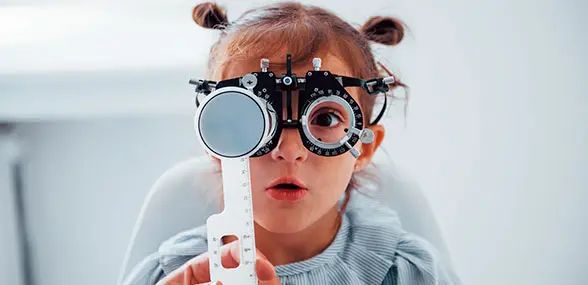Index
Amblyopia, more commonly known as 'lazy eye', is an incorrect development of the vision of one or both eyes during the first 7-8 years of life.
The portion of the brain responsible for vision, the occipital cortex, does not develop as well as the contralateral portion, and this causes blurred vision in the little patient.
Who can develop lazy eye and what are the causes?
- Strabismus: when the eyes are not perfectly aligned during the developmental period, the brain receives two different images and to avoid the phenomenon of confusion it ignores one of the two images by suppressing one eye.
- Mistakes refractive: such as myopia, hyperopia or astigmatism, especially if different in the two eyes (anisometropia).
- nystagmus: involuntary, rapid and repetitive movement of the eyes.
- Pathologies eyepieces, such as congenital cataracts
- Opacity corneal
- Ptosis eyelid
What are the symptoms?
How is amblyopia diagnosed?

A complete eye examination can determine the presence of amblyopia. The earlier the diagnosis is made, the greater the chance for effective treatment. For an early diagnosis of amblyopia, the Visual Evoked Potentials (VEP) can be performed, an electro-functional examination which consists in recording the electrical impulses generated by the nerve structures that depart from the retina and propagate up to the visual area of the brain following the presentation. of visual stimuli. When the child begins to be 5-6 years of age, more certain subjective information can be received with the examination of the visus, in particular through the game of Albini's "E". During this test, "Es" are presented in different directions and if the child's vision does not reach 10/10 is interrupted, single "E separate" stimuli are proposed to avoid the phenomenon of "crowding" ", present in affected children from amblyopia. In the event that the child, even with any optical correction prescribed, does not reach 10/10 with one or both eyes, he will be prescribed a personalized anti-amblyopic treatment.
How is amblyopia treated?

First, it is essential to treat the underlying disease; for example in the case of a vision defect, corrective lenses will be prescribed to cancel the refractive error. Subsequently, to improve the visual capacity in the amblyopic subject, the treatment par excellence is the bandage-occlusion of the healthy eye for a few hours a day, so as to be able to stimulate only the amblyopic eye. The anti-amblyopic treatment will always be performed with the glasses worn where the adhesive bandage will be applied directly under the glasses and on the fixing eye. In the case of binocular amblyopia the prescription of the occlusive treatment will be performed alternately between the two eyes. In any case, the treatment must necessarily take into account the severity and type of amblyopia but also the age and cooperation of the child. The more severe the amblyopia, the more significant the therapeutic measures must be; the younger the child, the more effective the therapy will be in terms of results and shortness of the therapeutic path. For better effectiveness, it is always recommended to have the treatment performed during the child's most active hours, for example while playing, coloring, reading or while at school. Satisfactory results are achieved if the bandage is started before the age of 5-6; after the age of 7-8 it is more difficult to stimulate an improvement in visual capacity since the process of formation of the visual cortex is almost completely concluded.
Two other treatment methods for amblyopia are the drug penalty and the optical penalty.
The pharmacological penalty is performed by instillating eye drops with atropine or cyclopentolate in the best eye, thus preventing the accommodation mechanism of the good eye and consequently promoting fixation with the amblyopic eye. In fact it is a penalty only for near as the mechanism of accommodation / convergence is a condition that we put in place in near vision, or in any case within 6 meters.
The optical penalty, on the other hand, is effective for distant vision and consists in the over-correction of the good eye through deliberately hyper-corrected glasses in order to favor the use of the amblyopic eye for distant objects.
Unfortunately, in most cases, the penalty is not a successful method in the treatment of amblyopia, especially if severe, as children continue to stare with the best eye even in the presence of blurred vision.
Prevention is essential because through early diagnosis and effective treatment, the chances of an eye becoming amblyopic can be considerably reduced and that over the years it can affect the young patient's vision and quality of life.

